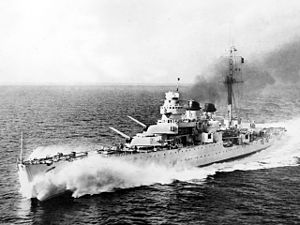This article includes a list of general references, but it lacks sufficient corresponding inline citations .(June 2023) |
 Luigi di Savoia Duca Degli Abruzzi during sea trials (1938) | |
| History | |
|---|---|
| Name | Luigi di Savoia Duca Degli Abruzzi |
| Namesake | Prince Luigi Amedeo, Duke of the Abruzzi |
| Builder | O.T.O., La Spezia |
| Laid down | 28 December 1933 |
| Launched | 21 April 1936 |
| Commissioned | 1 December 1937 |
| Decommissioned | January 1961 |
| Refit | 1953 |
| Fate | Scrapped 1972 |
| General characteristics | |
| Class and type | Duca degli Abruzzi-class cruiser |
| Displacement |
|
| Length | 171.1–187 m (561–614 ft) |
| Beam | 18.9 m (62 ft) |
| Draught | 6.9 m (23 ft) |
| Propulsion |
|
| Speed | 34 knots (63 km/h; 39 mph) (62 km/h) |
| Range | 4,125 nmi (7,640 km; 4,747 mi) at 13 kn (24 km/h; 15 mph) |
| Complement | 640 |
| Armament |
|
| Armour |
|
| Aircraft carried | 4 × Ro.43 |
Luigi di Savoia Duca degli Abruzzi was an Italian Duca degli Abruzzi-class light cruiser, which served in the Regia Marina during World War II. After the war, she was retained by the Marina Militare and decommissioned in 1961. She was built by OTO at La Spezia and named after Prince Luigi Amedeo, Duke of the Abruzzi, an Italian explorer and Admiral of World War I.